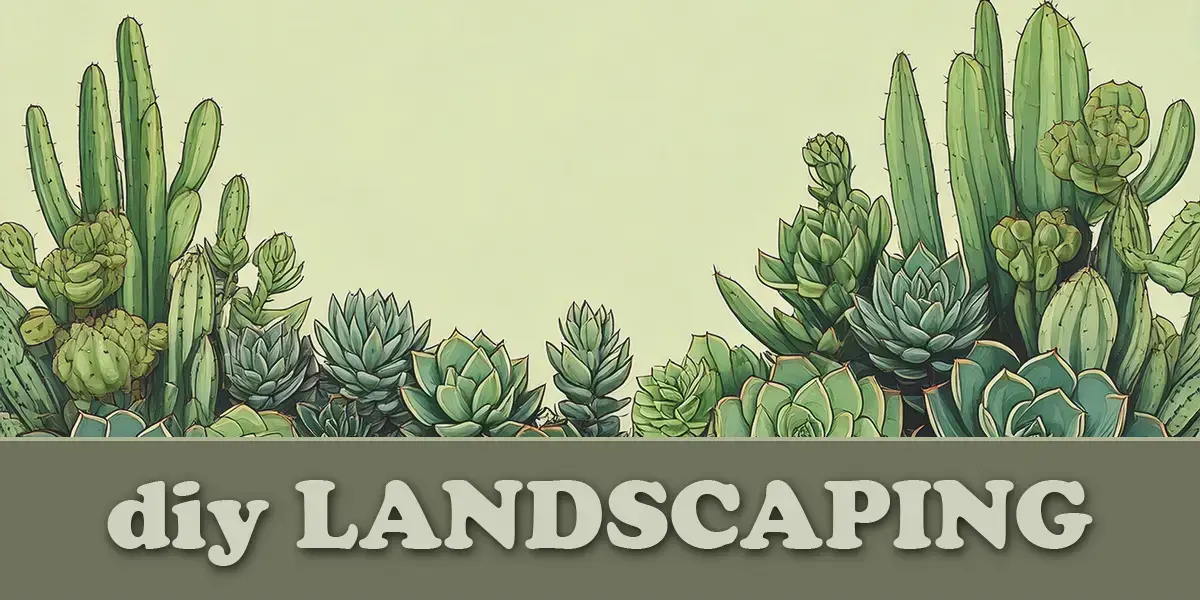Where would you rank your landscaping on a scale of 1-10?
Pleasant but forgettable earns you a 5. Anything less, and well… now’s the time to don your DIY hat.
There are countless ways to elevate your outdoor space affordably, from drought-tolerant plants to creative hardscaping.
In this blog, we’ve listed 10 impactful, beginner-friendly ideas tailored for the sun-soaked SoCal climate.
1. Design a Succulent Garden
Succulents are drought-tolerant and low-maintenance plants that thrive in Southern California gardens.
Materials
- Various succulent plants (Aloe Vera, Echeveria, Jade Plant, etc.)
- Well-draining soil
- Decorative gravel or mulch
- Planters or a designated garden area
How to Implement
- Choose a sunny area of your yard.
- Pull any weeds and mix sand onto the soil for better drainage.
- Sculpt the soil into low mounds for visual interest (optional).
- Plant succulents, grouping them by color or height.
- Add mulch or decorative gravel around the plants to give your garden a polished look.
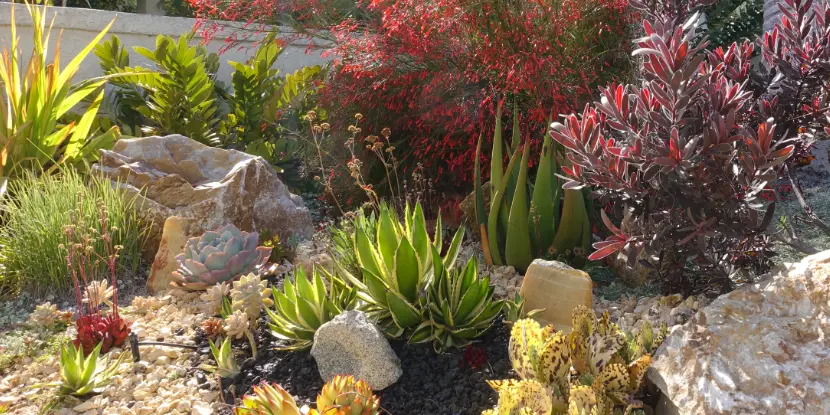
Succulents are the perfect choice for your low-maintenance garden.
2. Install a Gravel Pathway
A gravel pathway looks organically fabulous while keeping the mud off your shoes. It’s a straightforward project that doesn’t require special tools.
Materials
- Weed barrier fabric
- Gravel (decomposed granite works well for this)
- Small boulders or edging materials (optional)
- Shovel and rake
How to Implement
- Plan the route and design of your pathway.
- Clear the space and flatten the ground with a rake.
- Lay down weed barrier fabric to reduce future maintenance.
- Use boulder edging for a clean, finished appearance (optional).
- Add gravel evenly across the pathway and rake to level.
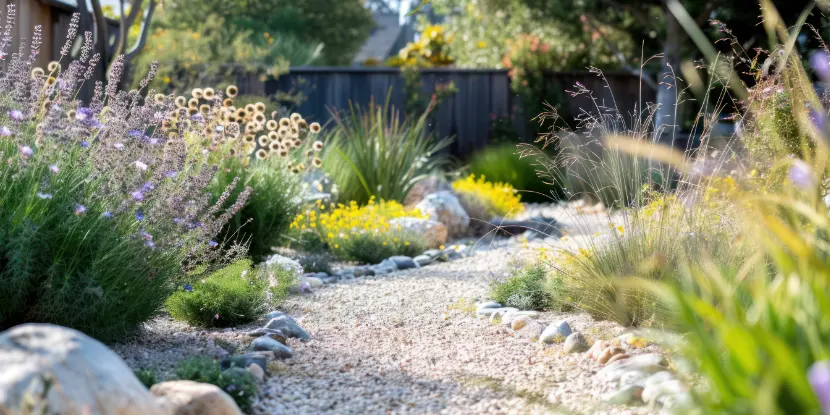
A gravel path looks organically fabulous while keeping the mud off your shoes.
3. Build Raised Garden Beds
Raised garden beds create clean lines in a yard while making gardening easy and accessible.
Materials
- Wood planks or ready-made garden bed kits
- Screws and a drill
- Soil and compost
- Seeds or plants
How to Implement
- Select a sunny spot and measure the area for your beds.
- Construct wooden frames out of planks.
- Fill the beds with a mix of compost and soil.
- Plant herbs, vegetables, or flowers according to your preferences.

Raised garden beds create clean lines in a yard while making gardening more accessible.
4. Add a Mini Water Feature
A small water feature can instantly transform your yard into a tranquil retreat and a magnet for wildlife.
Materials
- Large pot, ceramic container, or rubber or reinforced polyethylene liner
- Submersible pump
- Decorative rocks
- Solar or electric pump
How to Implement:
- Choose a shaded spot for your water feature to avoid algae buildup.
- Place the submersible pump in the container and fill it with water.
- Add decorative rocks around the pump to keep it in place.
- Plug in the pump and adjust the water flow.
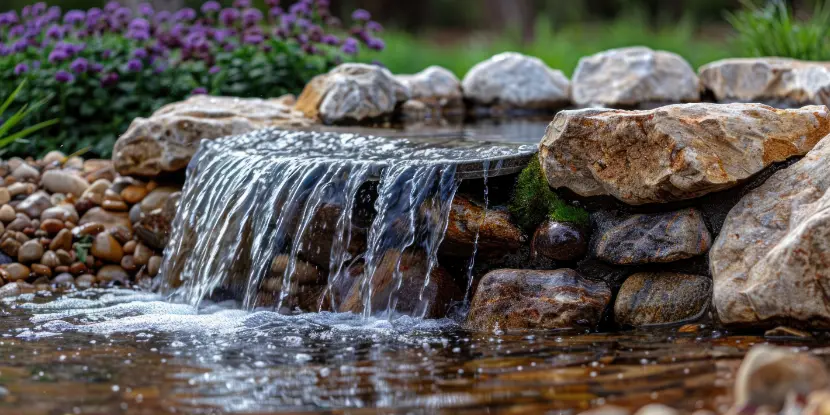
A small water feature can instantly transform your yard into a tranquil retreat.
5. Build a Flagstone Patio
A flagstone patio exudes class at a surprisingly affordable price. It’s so much nicer than concrete!
Materials
- Flagstones
- Sand and gravel
- Landscaping fabric
- Rubber mallet
How to Implement
- Mark out the desired patio area and remove grass or debris.
- Lay landscaping fabric to prevent weeds.
- Spread a layer of gravel, then sand, and level it out evenly.
- Arrange the flagstones in your preferred pattern, tapping them into place with the mallet.
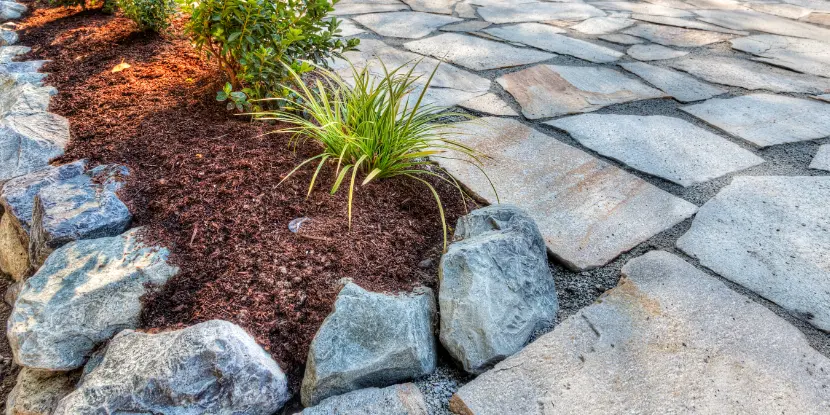
A flagstone patio is so much nicer than concrete!
6. Create a Vertical Garden
Got a small backyard? Maximize your space with a vertical garden.
Materials
- Wooden pallets or vertical planter kits
- Potting soil
- Small plant pots or felt pockets
- Herbs, flowers, or small veggies
How to Implement
- Mount a wooden pallet or vertical planter on a sturdy wall or fence.
- Fill each pocket with soil and your chosen plants.
- Water carefully, ensuring you soak the roots.
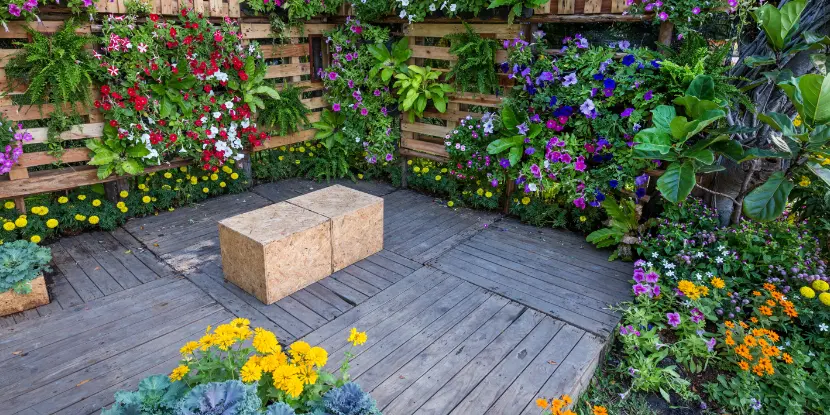
Maximize your outdoor space with a vertical garden.
7. Incorporate Mulch Landscaping
Mulch is a simple way to give your garden a facelift while conserving soil moisture.
Materials
- Mulch (bark, wood chips, or straw)
- Shovel
- Weed barrier fabric (optional)
How to Implement
- Clear the area of weeds and debris.
- Lay down weed barrier fabric for easy upkeep.
- Spread mulch evenly over your garden beds and around existing plants.
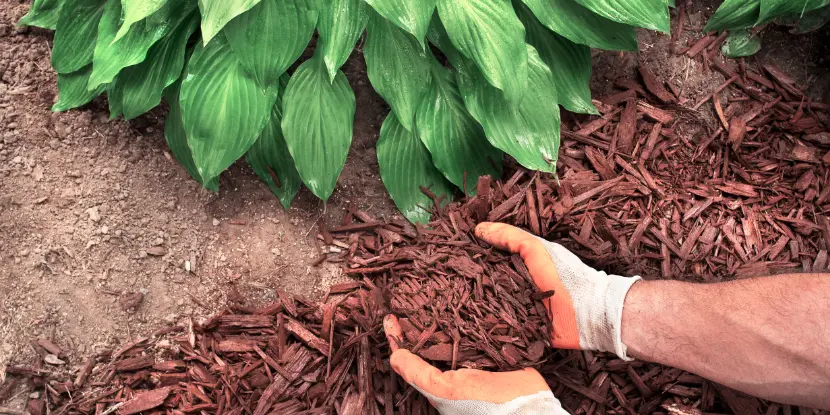
Mulch is a simple way to give your garden a facelift while conserving soil moisture.
8. Set Up a Cozy Fire Pit
Ghost stories and marshmallow roasts, anyone? A DIY fire pit converts your backyard into an entertainment zone.
Materials
- Fire bricks or cinder blocks
- Gravel or sand
- Lava rocks
- Shovel
How to Implement
- Choose a level spot to construct your fire pit.
- Dig a shallow circle where you want the pit.
- Line the circle with fire bricks or cinder blocks.
- Add gravel or sand at the bottom and top it with lava rocks for safety and aesthetics.
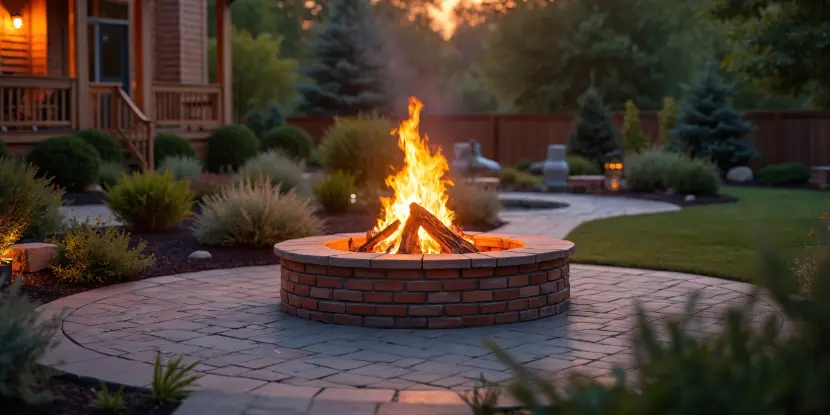
A DIY fire pit converts your backyard into an entertainment zone.
9. Plant a Native Wildflower Garden
Native wildflowers thrive in the Southern California ecosystem and attract pollinators, birds, and other wildlife.
Materials
- Native wildflower seed mix
- Garden rake
- Compost (optional)
How to Implement
- Choose a sunny spot and rake the soil to loosen it.
- Mix the wildflower seeds with sand for even distribution and scatter over the soil.
- Lightly press the seeds into the soil without covering them completely.
- Water regularly until the flowers germinate.
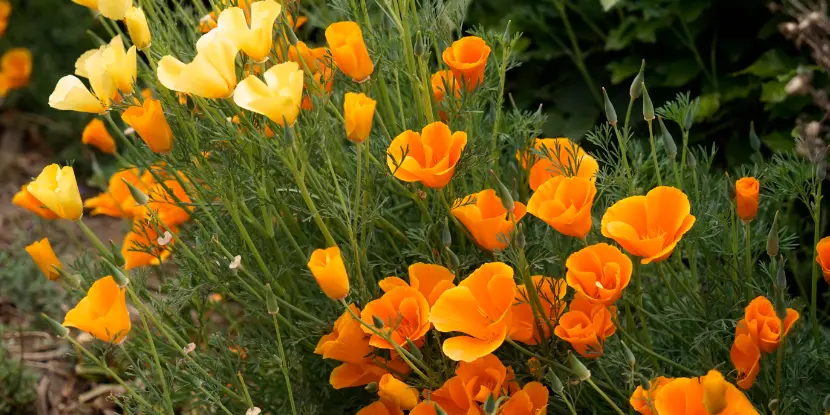
Native wildflowers thrive in the Southern California ecosystem and attract pollinators, birds, and other wildlife.
10. Suspend a Shade Structure
Beat the heat with a wow factor that lowers ambient temperatures and shades your patio, plants, or anything that needs cover.
Materials
- Wooden posts or steel poles
- Shade sail (UV-resistant, reinforced fabric)
- Screws and brackets
- Drill
How to Implement
- Dig holes for the wooden posts and secure them into the ground with concrete.
- Attach the shade sail with screws and brackets.
- Arrange the fabric at an angle for aesthetic appeal and optimal shade coverage.
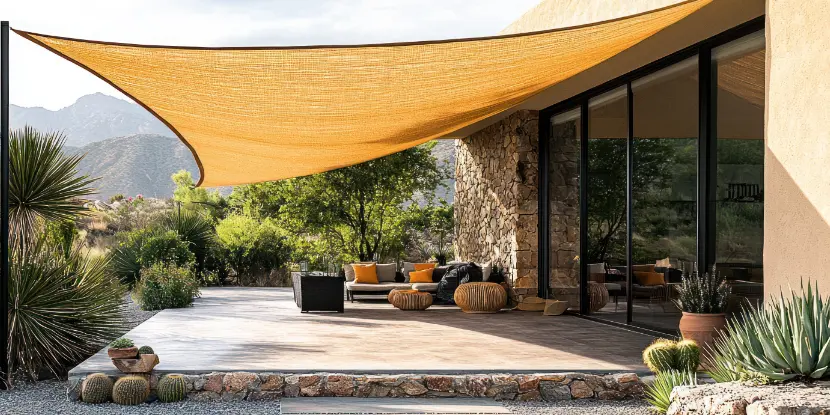
Beat the heat with a shade sail that lowers ambient temperatures and protects your patio and plants.
FAQs: DIY Landscaping
Q: What are the benefits of native plants for landscaping?
Native plants are drought-tolerant, low-maintenance, and help support local wildlife and ecosystems.
Q: What’s the best time to landscape in Southern California?
Winter and early spring are ideal due to cooler temperatures and the chance for seasonal rainfall.
Q: How can I conserve water while landscaping?
Use drought-tolerant plants, install drip irrigation, and add mulch to retain soil moisture.
Q: Can I DIY a sprinkler system?
Yes! Many home improvement stores offer easy-to-install sprinkler system kits with detailed instructions.
Q: How do I keep my DIY projects within budget?
Reuse existing materials, shop sales, and look for free resources like community composts or plant swaps.
Q: How do I choose the best plants for my yard?
Consider factors like soil type, sun exposure, and water availability. Visit local nurseries for advice.
Q: Can I landscape in a rented property?
Focus on non-permanent solutions like vertical gardens, planters, and portable decor.

